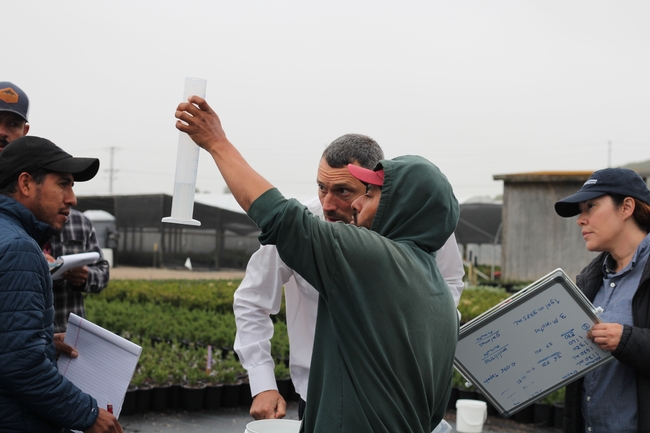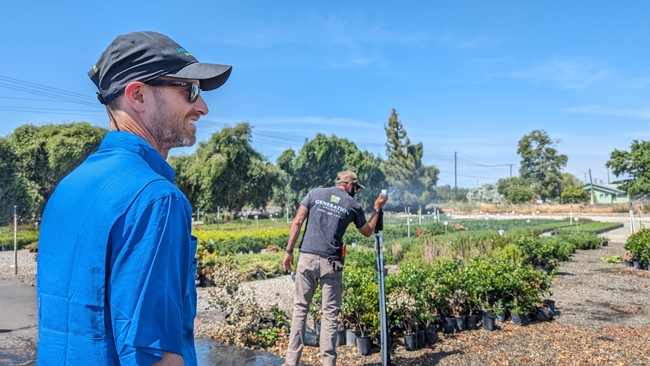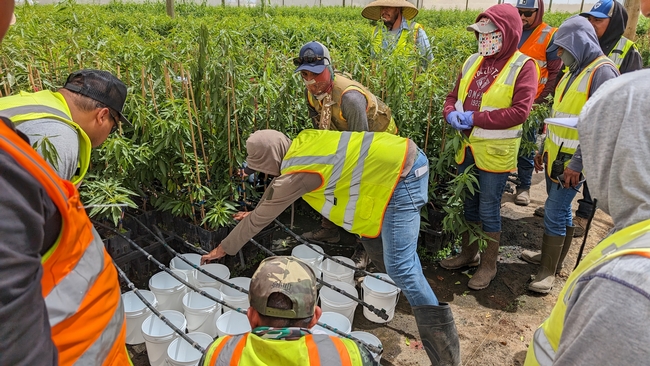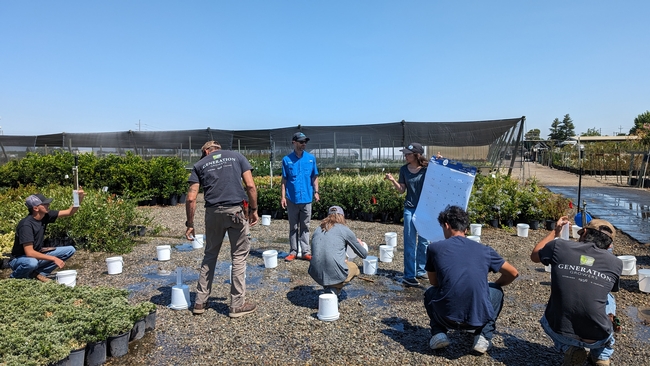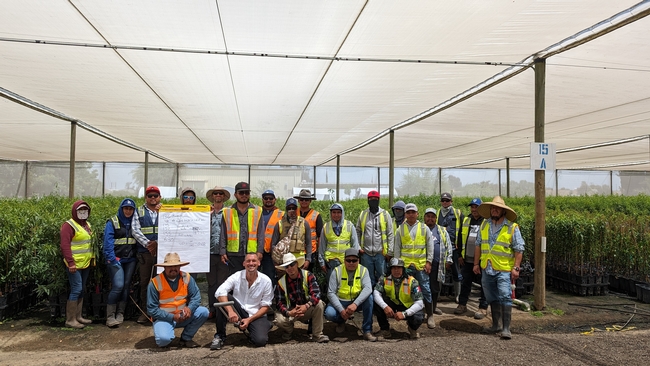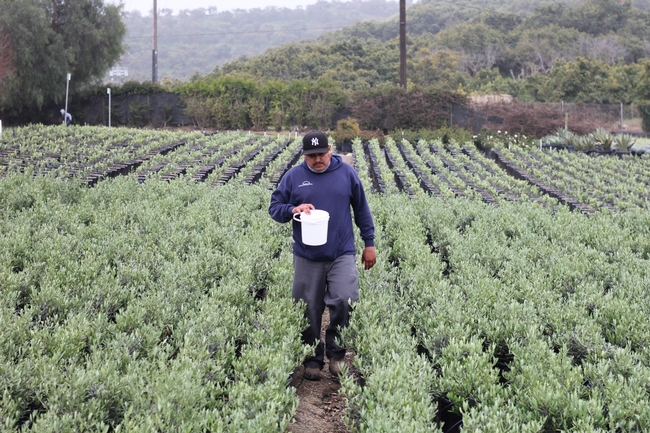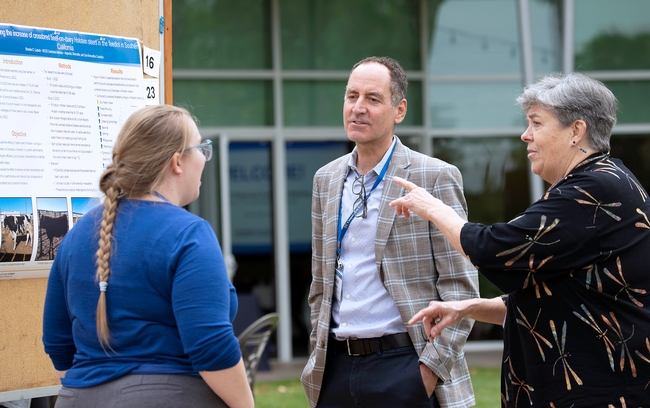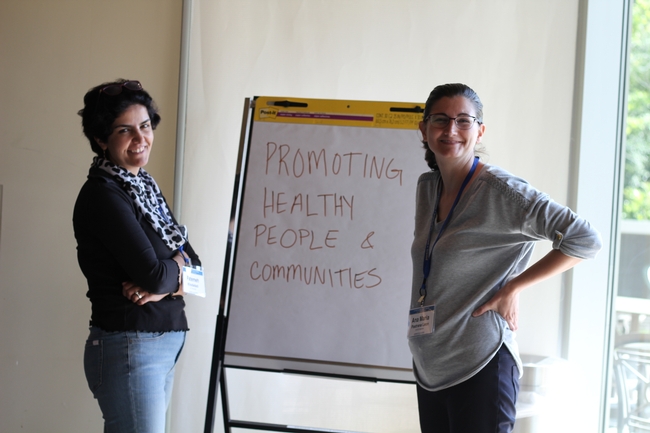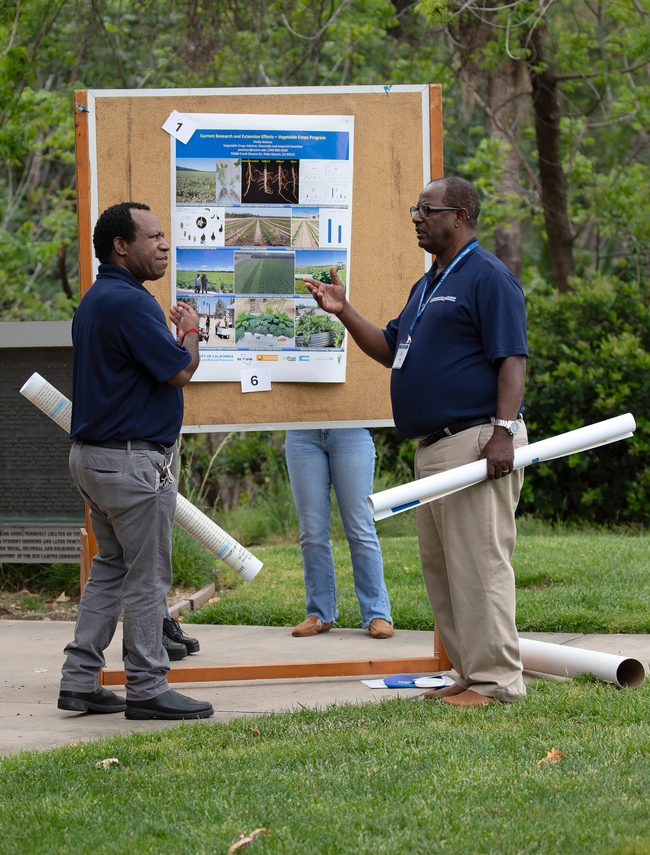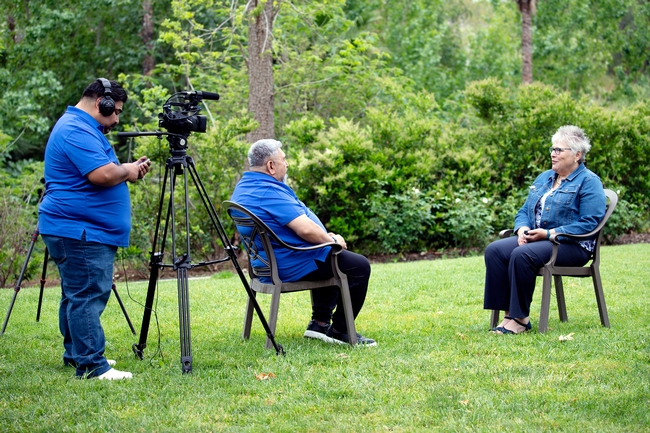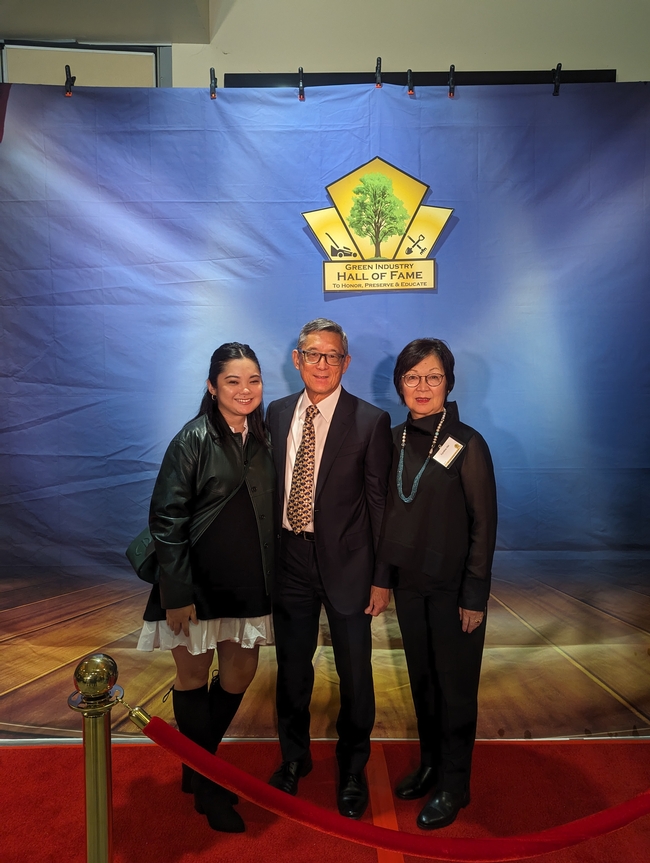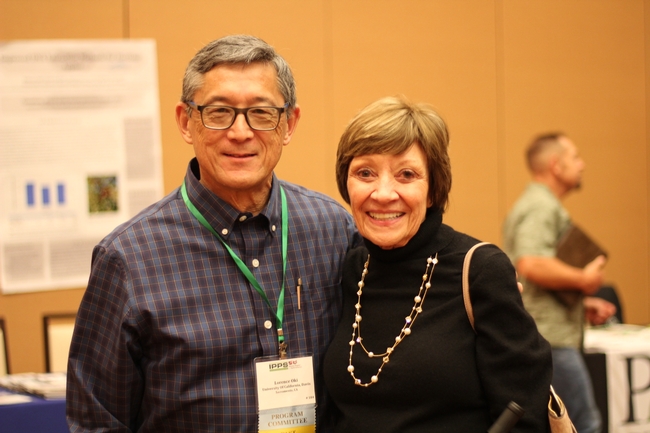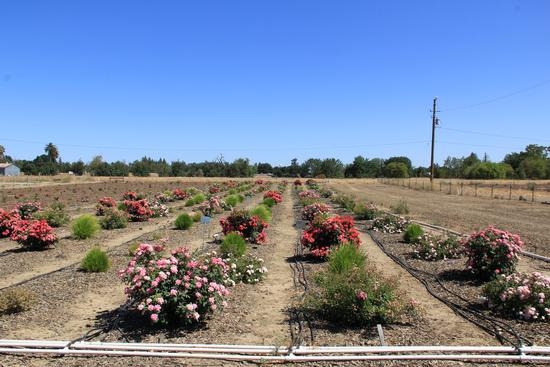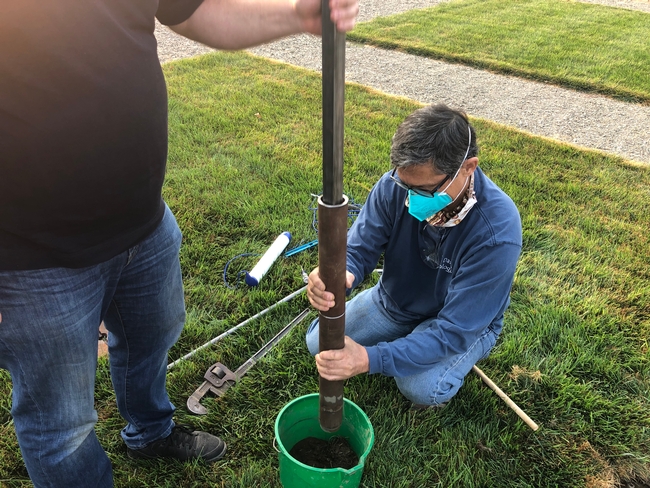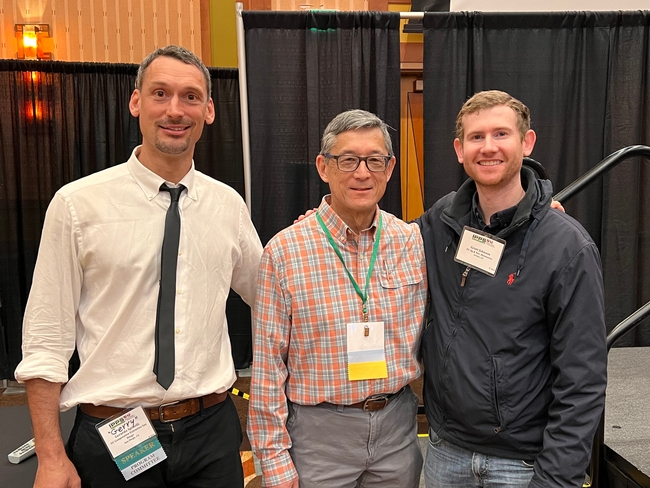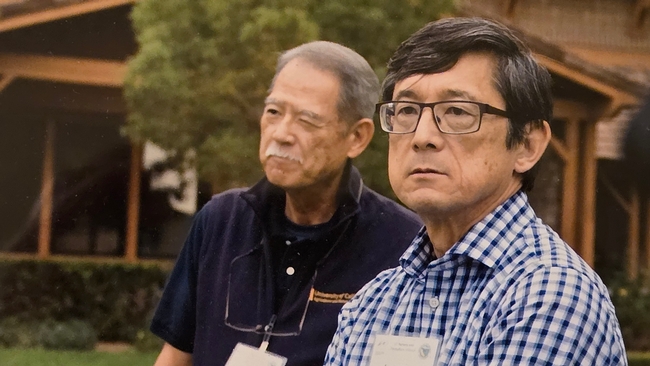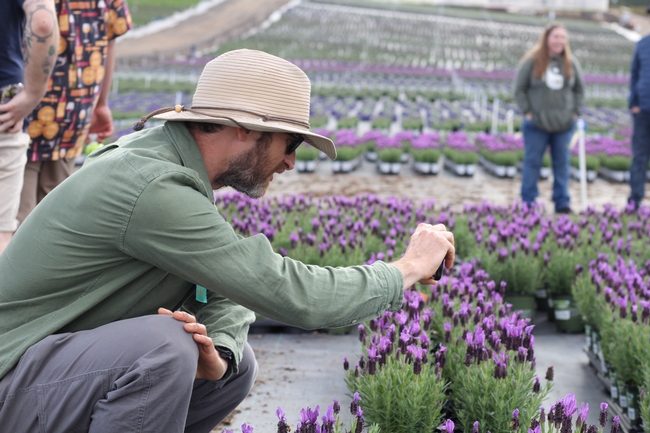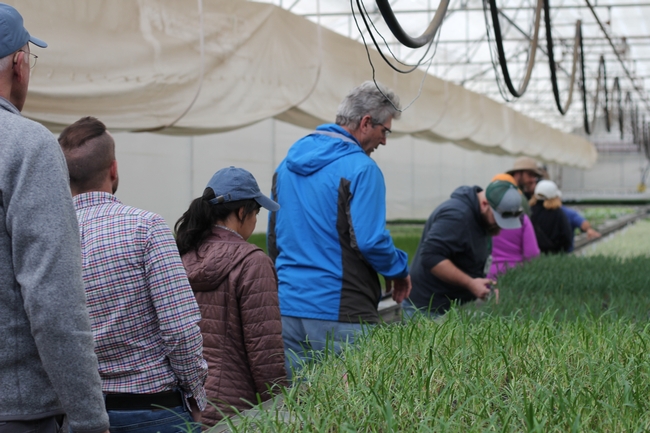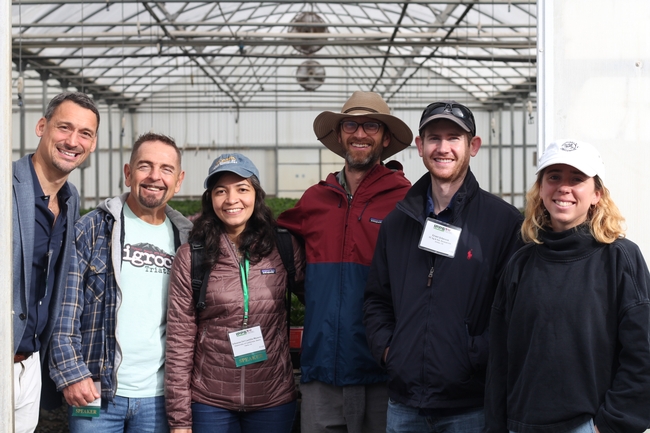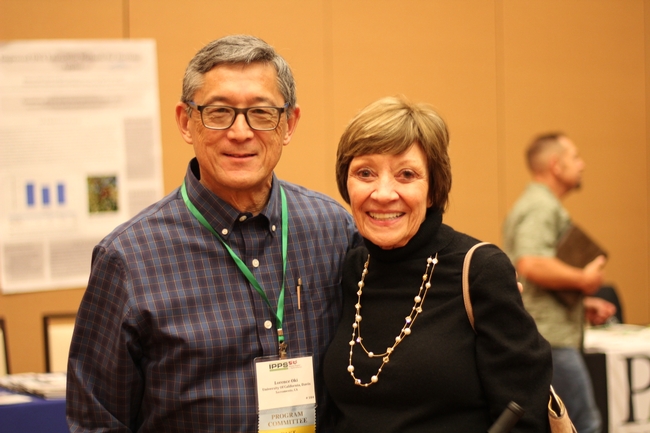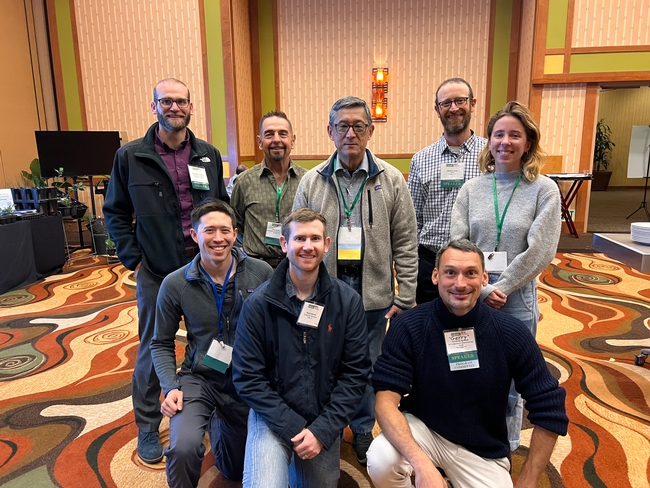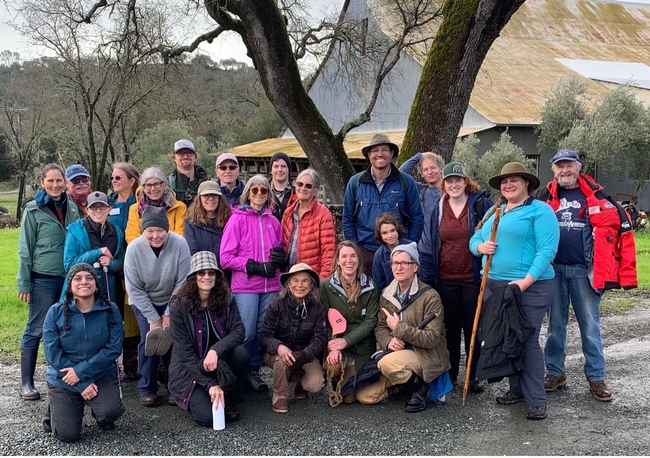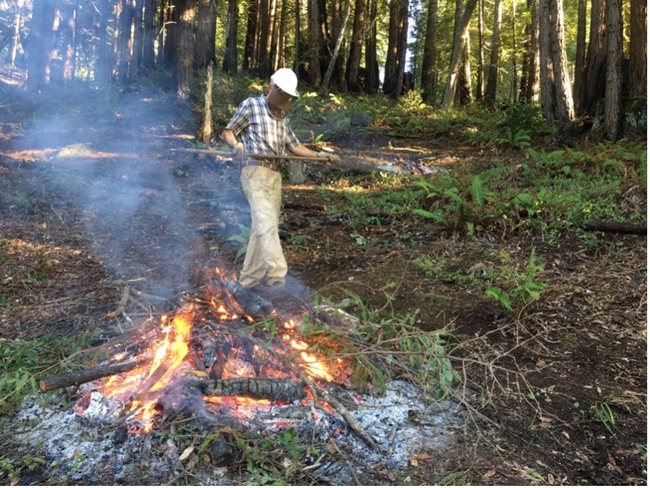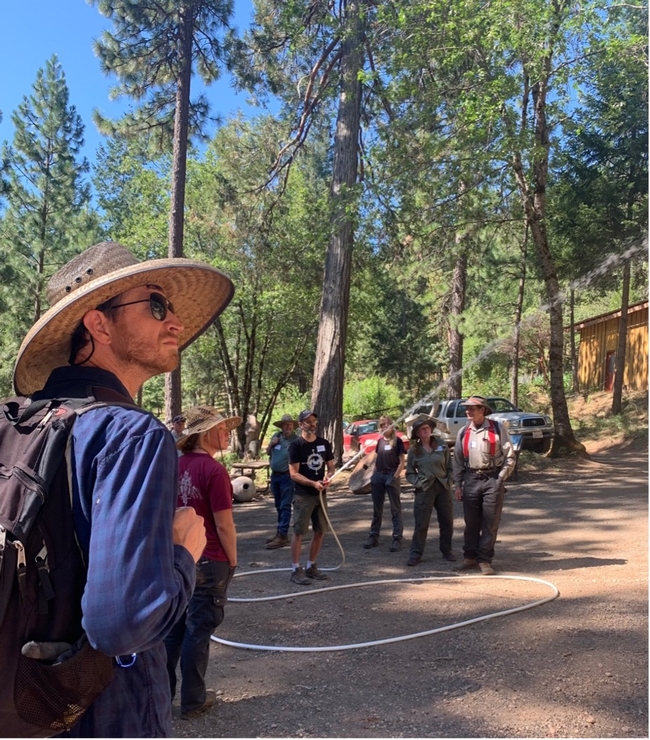Posts Tagged: natural resources
Hands-on learning, training make irrigation best practices accessible
UCCE advisors provide free training to nursery and greenhouse staff
Working as an irrigator seems straightforward at first: if you're not watering plants by hand, you're building and managing systems that can do the watering. What could be complex about a job like this?
University of California Cooperative Extension advisors Bruno Pitton and Gerardo “Gerry” Spinelli can tell you – or better yet, show you.
Pitton and Spinelli, members of the UC Nursery and Floriculture Alliance, offer a one-day technical training in irrigation best-management practices for irrigators working with containerized nursery plants. The comprehensive curriculum – developed with input from two focus groups of California nursery and greenhouse managers – aims to improve irrigation efficiency, reduce water consumption and improve plant health.
Thanks to funding from the California Department of Food and Agriculture, nursery and greenhouse managers in California can request this training for free and advisors like Pitton and Spinelli will travel to conduct the training on-site.
The complexities of irrigation incorporate concepts like evapotranspiration, salinity, irrigation uniformity, capillarity, pressure and flow rate. Spinelli, UCCE production horticulture advisor for San Diego County, said that irrigators have a critical role in the industry because of all the things they must consider to do their job well.
“Our goal is to support irrigators and help them become more confident decision-makers and experts in the field,” said Pitton, UCCE environmental horticulture advisor for Placer and Nevada counties.
Interactive sessions reveal nuances of irrigation
The training consists of a presentation on fundamental concepts for managing irrigation in container plant production and hands-on demonstrations. “In the nursery industry, where precise irrigation is crucial for the health and productivity of our crops, having access to expert knowledge is invaluable,” said Mauricio de Almeida, general manager of Burchell Nursery in Fresno County. “The training's practical demonstrations and real-world examples made the concepts easy to grasp, allowing our team to implement the strategies immediately.”
For one of the demonstrations, the advisors used sponges to model soil saturation when water is applied. Ana, an irrigator at Burchell Nursery, appreciated the step-by-step explanations, which helped her better understand how water pressure differs in drip irrigation, sprinklers and watering by hand. Doing this out in the field, as an example of how irrigation audits occur, was extremely helpful for attendees.
Francisco “Frank” Anguiano, production manager of Boething Treeland Farms in Ventura County, observed his team of irrigators as they learned how to measure distribution uniformity with water collected from sprinklers. “This training isn't just about irrigation and plant management. It's also about savings, both water and costs. Who doesn't want to save money and use less water?” Anguiano said.
Reducing the barriers to learning
Many of the irrigators attending these trainings gained their skills and knowledge from life experience rather than a college education, explained Peter van Horenbeeck, vice president of Boething Treeland Farms. “It's important that my irrigators learn from external experts, but it's more important that they can relate to them. And that's what Gerry was able to do,” van Horenbeeck added.
Regarding content and delivery, and referencing what he learned from the focus groups, Pitton wanted the trainings to be easy to understand and engaging. For example, scientists use the term “matric potential” to describe how soil particles hold water against gravity, which is the same as capillary rise. “We demonstrate this concept with a paper towel held vertically and dipped into a beaker of dyed water that it absorbs,” said Pitton.
Many of the irrigators in attendance agreed that hands-on activities and visual aids were instrumental to their learning. Charli, another irrigator at Burchell Nursery, shared that the in-field examples and hosting the training in Spanish kept them engaged.To address language barriers, Spinelli has been conducting trainings in Spanish – a common request from many nurseries with eager participants.
Maintaining state regulations and partnerships
Although the technical aspects of irrigation management are key elements of the training, regulatory compliance is also addressed. Recognizing the finite availability of water and the environmental impact of pollution, the advisors highlight irrigation and fertilizer management and runoff prevention as critical components of compliance.
Under Ag Order 4.0 administered by California's Water Resources Control Board, growers must comply with stricter policies regulating nitrogen use. As irrigators learn from the training, better control of irrigation can certainly make a difference.
Deanna van Klaveren, chief operating officer and co-owner of Generation Growers in Stanislaus County, said the most valuable aspect of the training was learning on-site and completing an audit on her own systems. “It is so much more impactful to have trainings like this on-site where our staff can learn and then go out into the nursery and actually put it into practice while the presenters/experts are there,” van Klaveren said.
Pitton and Spinelli described the partnership between UC Cooperative Extension and CDFA as “symbiotic” given the technical and educational capacity of UCCE advisors who conduct research and extension.
“It's a great example of how the two institutions can collaborate successfully. Californians are the ones who win because they get a service for free,” added Spinelli. “And it's rewarding for us to see so much interest in what we, as advisors, do.”
If you are a nursery or greenhouse operator and would like to request the Irrigation Best Management Practices training, please contact the UCCE advisor assigned to the region that corresponds with your nursery location below.
Northern California
- Jessie Godfrey, UCCE environmental horticulture and water resources management advisor, jmgodfrey@ucanr.edu
Central Coast (Santa Cruz County to Ventura County)
- Emma Volk, UCCE production horticulture advisor, evolk@ucanr.edu
San Joaquin Valley
- Chris Shogren, UCCE environmental horticulture advisor, cjshogren@ucanr.edu
Southern California
- Grant Johnson, UCCE urban agriculture technology advisor, gejohnson@ucanr.edu
Spanish Trainings Only
- Gerry Spinelli, UCCE production horticulture advisor, gspinelli@ucanr.edu
ANR regional meetings kick off with SoCal academics
In late April, University of California Agriculture and Natural Resources hosted its first regional meeting for UC Cooperative Extension advisors and specialists based in Southern California. The meeting, hosted by Daniel Obrist, vice provost, and Lynn Schmitt-McQuitty, director for county Cooperative Extension, brought together 50 participants over two days for networking and collaboration.
Based on feedback collected from ANR's Statewide Conference in April 2023, academics indicated a desire to meet more frequently opposed to waiting for the conference that occurs every five years. As a result, ANR is hosting regional meetings throughout California to provide an in-person opportunity for academics to discuss their research projects, interact with senior leadership, gain clarity related to merit and promotion, strengthen communication skills and network.
On the first day, academics had the option to attend an Impact and Outcome Writing Workshop presented by Martin Smith, Emeritus Professor of Cooperative Extension at UC Davis. The session also included an interactive segment, facilitated by Katherine Webb-Martinez, director of program planning and evaluation, and Christina Becker, program policy analyst for PPE, that broke down impact reporting into theory and application.
To end the day on a social note, attendees were invited to dinner where they could continue informal discussions and networking. During that time, academics got to interact with senior leaders, including Obrist and Schmitt-McQuitty, county and Research and Extension Center (REC) directors such as Rita Clemens for Riverside, San Bernardino and Orange counties, and Jairo Diaz of Desert REC, as well as statewide support staff like News and Information Outreach in Spanish (NOS).
“A key opportunity of these meetings is to build peer networks with colleagues and collaboration opportunities in the regions. So many of our academics are new to ANR, and the regional meetings allow us to welcome and onboard new colleagues and get to know each other,” Obrist said.
The meetings are also beneficial for those transitioning into a new academic role within ANR. Natalie Levy who currently works as a specialist for water resources at South Coast REC, participated in the meeting with her new position, soil health and organic materials management advisor, which begins June 3, in mind.
“It was helpful to have senior leadership present. I spoke to Lynn the most and she gave me good feedback about developing a new program and my research interests,” Levy said. “I also liked the session discussing merit and promotion because it gave me a framework to use as I step into a new role.”
The morning of the second day, academics participated in a poster session to share their research with colleagues. Attendees also engaged in discussions to understand and address regional needs, build new partnerships and engage senior leadership for support.
“I learned a lot about my colleagues from the poster session. I felt more connected to their work because I could visualize how we can collaborate,” said Ashley Hooper, urban community resiliency advisor for Los Angeles County. “It can be isolating for advisors who don't have counterparts in other counties or in ANR. Seeing how others are managing their programs during the poster session gave me reassurance that I'm on the right track in my position.”
In the afternoon, academics heard from Vice President Glenda Humiston, who addressed ANR's budget and career pathways for academics. Niamh Quinn, human-wildlife interactions advisor for Los Angeles, Orange and San Diego counties, presented on the merit and promotion process to remind academics that “swallowing the eBook” (Guidelines for UC ANR Academics Preparing the Thematic Program Review Dossier) is the best way to learn how merit and promotions work within ANR.
Finally, Saoimanu Sope, digital communications specialist, showed academics how to leverage social media as an extension tool. Ricardo Vela, program manager for News and Information Outreach in Spanish, and Miguel Sanchez, broadcast communications specialist for NOS, described how to produce videos using a smartphone.
“It was useful to see colleagues from other counties, especially those who work in different disciplines,” said Quinn, who, like Hooper, is programmatically isolated given her program niche. As someone who uses social media for her program, Quinn described the social media presentation as informative. “I felt better educated and equipped to make improvements afterwards,” she said.
The regional meeting schedule is as follows:
Region 3: May 30-31, at UCCE San Joaquin County Building in Stockton
- Counties: San Joaquin, Stanislaus, Merced, Mariposa, Mono, Inyo, Madera, Fresno, Tulare, Kings and Kern
- RECs: Kearney, Westside and Lindcove
Region 5: June 10-11, at UC Santa Cruz
- Counties: Sonoma, Napa, Marin, Contra Costa, San Francisco, San Mateo, Alameda, Santa Clara, Santa Cruz, San Benito and Monterey
Region 2: Sept. 12-13, Central/Northern Sierras, specific location TBD
- Counties: Tehama, Glenn, Butte, Colusa, Sutter, Yuba, Nevada, Placer, El Dorado, Yolo, Solano, Sacramento, Amador, Calaveras and Tuolumne
- REC: Sierra Foothills
Region 1: Feb. 26-27, 2025, Redding, specific location TBD
- Counties: Del Norte, Siskiyou, Modoc, Humboldt, Trinity, Shasta, Lassen, Mendocino, Lake and Plumas-Sierra
- RECs: Intermountain and Hopland
Green Hall of Famer Oki retires after 29-year UC career
UCCE specialist's research prevents water pollution, reduces water use
When interviewed to become a University of California Cooperative Extension specialist in environmental horticulture, Lorence “Loren” Oki was asked what kind of research he wanted to conduct.
In response, he showed the hiring committee a photo of a residential gutter. “Water is a big concern, and I found very little research on runoff from homes,” said Oki, explaining that studying residential runoff is what “started his career” with UC Agriculture and Natural Resources back in 2002.
Although he remains active supporting growers and advising industry leaders, Oki retired from UC ANR in July 2023. Before joining ANR, Oki worked as a researcher for UC Davis' Department of Environmental Horticulture studying greenhouse irrigation in 1994, bringing his total time with the University of California to 29 years.
Oki, professor emeritus of Cooperative Extension at UC Davis, led many research projects that advanced the green industry which includes landscapes, nurseries and floriculture.
“Loren is the epitome of a specialist,” said Darren Haver, UC ANR's Research and Extension Center system director, who has worked with Oki for more than 20 years on projects that have significantly improved urban water quality and water conservation efforts across California.
Research influences pesticide management
With a $3 million grant funding a statewide study, Oki and Haver set out to characterize runoff from residential sources over a five-year period. They determined the volume of irrigation runoff from residential land use, as well as the pollutants in the runoff.
Oki and Haver, co-principal investigators, along with researchers from UC Davis and UC Riverside, discovered that the degradation products of the insecticide fipronil – commonly found in runoff water – were more toxic than its parent compound. The study led to an investigation of human pathogens and pathogen indicators in residential runoff, the first of its kind.
Another contribution was the early detection of a new pesticide used for ant control, enabling strategies to be put in place to prevent it from reaching local streams and creeks. Oki and Haver's work also persuaded the California Department of Pesticide Regulation to change pesticide labels to minimize the chances of pesticides moving off target during irrigation and rain events.
These changes included preventing pesticide application before predicted rain and preventing irrigation after applications, keeping pesticides from impervious surfaces, and restricting applications on lawns and landscape beds within two feet of impervious surfaces and others.
Plant trials expand beyond California
Oki was also the principal investigator of the Climate-Ready Landscape Plants project, which may be the largest irrigation trial in the western U.S., and the UC Plant Landscape Irrigation Trials, the California component of that project. The UCPLIT trials originated in 2004 at UC Davis as a research project by Karrie Reid, retired UCCE environmental horticulture advisor for San Joaquin County, while she was pursuing her master's degree. In 2017, the irrigation trials were duplicated at the South Coast Research and Extension Center.
These projects evaluate landscape plants under varying irrigation levels to determine their optimal performance in regions requiring supplemental summer water. Throughout the trial, Oki identified many landscape plants, including rose cultivars, that remain aesthetically pleasing with little water.
Today, the trials have expanded beyond California as the Climate-Ready Landscape Plants Project at Oregon State University, University of Washington, University of Arizona and Utah State University.
Growing up in the nursery industry
In 2017, Oki obtained tenure, allowing him to expand his professional responsibilities to include production horticulture, specifically greenhouses and nurseries, an industry he was extremely familiar with. “I come from a nursery family,” Oki explained. “My grandfather started Oki Nursery in the early 1900s.”
During World War II, Oki's family was incarcerated in the Poston Relocation Center in Arizona and lost their homes and property. When they were released, they returned to the nursery industry to rebuild their lives. “After World War II, my father and uncle got more involved with my grandfather's work,” he said.
The Oki family played an instrumental role in technological development for nurseries in general. Oki Nursery, which was located in Sacramento, worked closely with IBM and was the first to use a computerized system in the industry.
Oki developed computerized scheduling for the bedding plants, poinsettias, chrysanthemums, bulbs and other crops. He developed a method to calculate the cost of any crop grown by the nursery at any point in the crop cycle and computerized greenhouse environmental and irrigation controls. This may not sound impressive now, but that was in the 1980s.
“My father was known for being progressive and he also knew everyone at UC Davis,” said Oki. “He wanted to work with anyone who had an interest in doing something good for nurseries.”
Inducted into Green Industry Hall of Fame
In the 1950s, Oki Nursery partnered with researchers from UC Davis' agricultural engineering program and developed the overhead sprinklers commonly used in nurseries today. Until the 1980s, Oki Nursery was the largest nursery in Northern California. Before it shut down in 1993, Oki worked in the family business as a greenhouse manager when runoff became a growing concern.
“I remember getting served with a notice by the Regional Water Quality Control Board stating that we needed to prevent runoff because it was polluted with nitrate fertilizer, which was common in the nursery industry,” Oki said.
One of those efforts focused on using controlled-release fertilizer instead of applying fertilizer via irrigation as a liquid feed. “What we learned is that if we converted nurseries to controlled-release fertilizer, we could reduce the nitrate runoff,” he said. While a member of the Oki Lab, Bruno Pitton earned his Ph.D. studying nursery hydrology and the fate of nitrogen fertilizers in container crop production adding to the information on runoff and nitrate management. Pitton is now the environmental horticulture advisor for Placer and Nevada counties.
In 2023, Oki was inducted into the Green Industry Hall of Fame, which recognizes individuals with a minimum of 20 years in the landscape, nursery or floriculture industry and who have made significant contributions to the field.
Having grown up in the industry, Oki said that his father taught him to never be afraid to try new things. “If you think you have an idea that might work, do the best you can to make it work. If it doesn't work out, then it doesn't work out. And that's OK,” he said.
Revitalizing space for greater impact
This mentality encouraged Oki whenever tackling new tasks, like rebranding the California Ornamental Research Federation, a space for education and collaboration, as UC Nursery and Floriculture Alliance.
In 2009, Oki and David Fujino, executive director of the California Center for Urban Horticulture, became co-directors of CORF, which catered to the cut flower industry. At that time, Oki and Fujino realized that nurseries generated much greater revenue in the state than cut flowers.
“It was a strategic decision to change CORF to UCNFA, which included floriculture and nurseries in the name,” Fujino said. Combined, nurseries and floriculture have consistently placed in the top five agricultural commodities in the state.
When reflecting on their partnership, Fujino said that working with Oki was a “natural fit.” “I couldn't have asked for a better partner, a better colleague and, ultimately, a better friend to have my back and work side by side,” he added.
Since UCNFA's launch, the two have worked to maintain the group's impact by hosting “Ask your Advisor” webinars to connect advisors to growers, as well as co-hosting large-scale events such as the annual conference for the International Plant Propagators' Society — an organization focused on greenhouse and nursery production education — for the Western Region, which Oki's father helped establish in the 1960s.
Encouraging a return to education
Gerry Spinelli, UC Cooperative Extension production horticulture advisor for San Diego County and member of UCNFA's administrative committee, described those who have learned from Oki as his sons and daughters. “When I meet someone that's learned from Loren or worked with him, that person instantly becomes my friend. That's the kind of effect Loren has on us,” Spinelli said.
Grant Johnson, UC Cooperative Extension urban agricultural technology advisor for Los Angeles and Orange counties, credits Oki for his master's degree in horticulture from UC Davis.
“Loren gave me a lot of direction as far as career choices and research interests. He instilled in me a dedication to life-long learning, just like he continues to do,” said Johnson. Before Oki became his professor, Johnson worked with Oki as a staff research associate at the South Coast Research and Extension Center in Irvine.
Another influential person in Oki's life is John Kabashima, emeritus environmental horticulture advisor for UCCE Orange and Los Angeles counties and fellow Green Hall of Fame inductee. Like Oki, Kabashima grew up in the nursery industry.
Oki, who earned a bachelor's degree in ornamental horticulture from Cal Poly San Luis Obispo and a master's degree in plant science from UC Riverside, decided to pursue a Ph.D. in ecology at UC Davis with Kabashima's encouragement.
While Oki was still working in his family's business, Kabashima said that Oki relied on UC ANR researchers for scientific information and felt like Oki wanted to be one of them. “I told him that he's a good nursery guy, but he's a better scientist,” said Kabashima. “His heart is in science.”
The two began working together as soon as Oki became a graduate student and have been colleagues and friends for nearly 40 years. “My favorite response from Loren whenever people ask him a question is, ‘It depends,'” Kabashima said. “It always leads to people opening up and giving more context. That's what Loren does, he gets you to think.”
UCCE academics enliven Western Region International Plant Propagators’ Society meeting
In late January, the University of California Nursery and Floriculture Alliance co-hosted the 62nd Western Region International Plant Propagators' Society (WR-IPPS) Annual Meeting in Temecula.
UCNFA, associated with the Nursery and Floriculture Workgroup of UC Agriculture and Natural Resources, is a statewide partnership of researchers and educators, growers, floriculture associations and allied industries. It serves the educational needs of California's agricultural industries that produce greenhouse crops and nursery products including vegetable seedlings, ornamentals, fruiting trees, vines and shrubs.
“Up until 2007 and before almonds and grapes became a big deal, nursery and floricultural products were the top crop commodity in the state,” said Loren Oki, specialist emeritus of Cooperative Extension at UC Davis and co-director of UCNFA. “Nurseries and floriculture are a $3.6 billion industry in California, but not many people know about it.”
Since its inception in 1951, IPPS has sought and shared plant production knowledge globally with an emphasis on nursery production. Oki has been a member of IPPS since the 1980s. His father, George, who owned and operated Oki Nursery, helped establish the Western Region in the 1960s, paving a path for Oki who served as president of WR-IPPS in the 1990s.
Although this year was the first that UCNFA co-hosted, Oki is confident that it won't be the last. “We're already planning a conference for the fall in conjunction with WR-IPPS. Since the target audience of UCNFA are growers, it just makes sense to partner with growers for these events,” Oki said.
This year's meeting involved 145 attendees, 29 exhibitors and 23 speakers and occurred over four days – two of which were dedicated to grower tours and the other two offering educational presentations in both English and Spanish, another first for WR-IPPS.
Gerry Spinelli, UC Cooperative Extension production horticulture advisor for San Diego County and member of UCNFA's administrative committee, was instrumental in coordinating the event. When he wasn't moderating sessions or facilitating Q&A, Spinelli was sharing his expertise on measuring pressure, distribution uniformity and improving irrigation management in English and Spanish.
“It's rewarding to see so much statewide interest in nurseries and floriculture,” said Spinelli. “WR-IPPS is a great opportunity to showcase the extraordinary San Diego nursery and greenhouse industry on an international stage, and a perfect occasion for clientele to meet our new UC Cooperative Extension advisors.”
Bruno Pitton, who became the UCCE environmental horticulture advisor for Placer and Nevada counties in November, appreciated the increase in science-based talks compared to previous years.
“Before, there were more talks on production practices from grower to grower. This year, I noticed that there's more science extension talks – which is a good thing,” said Pitton, who also gave a presentation on nitrogen management in nursery production and irrigation training.
Recent UC ANR hires like Emma Volk, production horticulture advisor for Ventura and Santa Barbara counties, had the opportunity to learn not only from industry leaders nationwide, but fellow ANR colleagues. For example, she heard Don Merhaut, UCCE specialist for nursery and floriculture crops based at UC Riverside, present on controlled release fertilizer dynamics in containers during a one-year growing cycle for Southern California.
UCCE advisors and specialists had a significant presence at this year's meeting, leaving a positive impression on attendees, including Tony Shireman, WR-IPPS president, who said that partnering with UC ANR experts helps IPPS achieve its mission to seek and share plant knowledge globally.
“We're fortunate to have connections to people like those joining us from Cooperative Extension. It allows us to expand our knowledge and extend our reach,” Shireman said.
Johanna Del Castillo Munera and Kosana Suvocarev, two professors of Cooperative Extension at UC Davis, also attended and joined Spinelli for both English and Spanish sessions. Del Castillo Munera presented on disease challenges and management for nurseries, and Suvocarev talked about crop water requirements for irrigation scheduling in nurseries and greenhouses.
“There's a good sense of community here and there's a lot of passion from the speakers,” said Grant Johnson, UCCE urban agriculture technology advisor for UCCE Los Angeles and Orange counties, adding that he valued the opportunity to learn from growers and scientists simultaneously.
After attendees spent an entire day touring local nursery and floriculture operations and learning from growers in North San Diego County and Riverside County, they concluded the day with a dinner and keynote address from Karen Ross, California Department of Food and Agriculture secretary.
On the last day, Chris Shogren, UCCE environmental horticulture advisor for Los Angeles County and member of UCNFA's administrative committee, and Eric Middleton, UCCE integrated pest management advisor for San Diego, Los Angeles and Orange counties, talked about pest and pathogen management. The advisors offered fascinating visuals including photos comparing the size of agave mites to a penny, and led a stimulating Q&A session.
To learn more about the UC Nursery and Floriculture Alliance, visit https://ucnfa.ucanr.edu/.
Forest research and outreach compiles forestry voices in new story map project
For the past four years, Kim Ingram has been listening closely to the private forest landowners who participate in her Forest Stewardship Workshop series. During the workshops, landowners share their experiences clearing thickets of vegetation, replanting post-wildfire and tackling invasive species, and their concerns of who will take care of their forest when they're gone.
To alleviate their stress, Ingram–Forest Stewardship Education coordinator with University of California Agriculture and Natural Resources–turns to natural resource professionals from CAL FIRE, local Resource Conservation Districts, and the U.S Forest Service who can share knowledge and resources with participants. Recently, Ingram developed a story map that aims to provide landowners with a platform they can use to share their experiences and ways that they have been empowered to manage their land.
"It's not uncommon for small forest landowners to feel overwhelmed with their forest management responsibilities and uncertain over what steps to take first," said Ingram. "Through the Forest Stewardship Workshops and this story map project, we hope to show that there is an entire community of forest landowners in the same situation, learning from each other and moving forward towards their management goals."
The Forest Stewardship Story Map team used ArcGIS StoryMaps to design the project, with 15 participants providing interviews and visual content. StoryMaps provides a user-friendly interface where website visitors can either click on a county to view specific interviews or scroll to view the stories.
The forestry team plans to interview at least one landowner and natural resource professional in every forested county in California so private forest landowners have a local contact or can become inspired by a project in their area.
Theresa Ciafardoni, a forest landowner in Nevada County, said that the UC ANR Forest Stewardship Workshop helped her manage postfire restoration and long-term land use planning.
"It opened up so many options and possibilities," said Ciafardoni. "All the individuals who presented in the Forest Stewardship Workshop were open to phone calls for specific questions and provided invaluable technical assistance."
Involving landowners and forestry professionals with this project was an early decision made by Ingram, who believed it was important that the map held appeal beyond hosting stories. Now, the project functions as a networking tool for landowners seeking professional assistance, too.
Past Forest Stewardship Workshop presenters shared their contact information and the motivations behind their forest management work so that landowners could find assistance in their area. The professionals currently hosted on the map include Resource Conservation District managers, UC ANR forestry advisors and private contractors.
"The most motivated landowners are invested not only economically, but their heart is into it," said Ryan Tompkins, UC Cooperative Extension forestry advisor for Plumas, Sierra and Lassen counties. "The natural world is full of uncertainty, but they're committed to continuing education and learning about how to be a good land steward. This takes a certain level of humility recognizing that our tenure as a steward on the land is a very short period of a forest's lifetime."
Looking ahead, the team envisions the map as a working document that will eventually include interviews with indigenous tribal members who focus on traditional ecological knowledge projects, interviews and information from the UC ANR Postfire Forest Resilience Program, and a feature that will filter stories by topic (e.g. reforestation or prescribed burning).
"This isn't a project that could be completed by one person," explained Grace Dean, Forest Stewardship communications specialist. "The same way that Kim and other presenters explain forest management as a collaborative process holds true for this project."
The Forest Stewardship Workshop series gives participants the ability to start as beginners and build upon their knowledge and experiences. In the same vein, this story map provides the Forest Stewardship team a solid base of real stories to add on to over time. The hope is that it will grow into a multifaceted tool reaching new forest landowners, eventually enveloping their stories within the small forest landowner community.
To view the Forest Stewardship Story Map, visit: https://storymaps.arcgis.com/stories/bd062108d9894da7920d7aef06fe2c2c.

